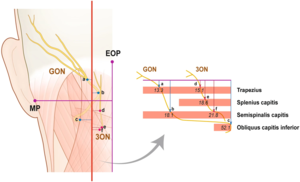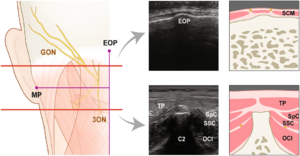Third Occipital Nerve Injection
| Third Occipital Nerve Injection | |
|---|---|
| Indication | Confirmed or suspected pain arising from a C2-3 facet joint. |
| Needle | 2.5 inch 22-gauge |
| Steroid | nil |
| Local | 3 x 0.3mL 1:1 with contrast |
| Volume | 0.9mL |
Background
Anatomy
- Main article: Third Occipital Nerve


The third occipital nerve (TON) arises from the medial branches of the posterior ramus of the third cervical spine nerve. It arises between the axis and third cervical vertebral, with or without a communicating branch with the GON. It provides sensory distribution to the lower aspect of the posterior suboccipital neck, dividing into 1-3 ascending branches which nearly reach the superior nuchal line. See Kim et al for a review of the anatomy[1]
Indications
Contraindications
Technique
Ultrasound Guided
The third occipital nerve can be blocked using ultrasound guidance, which is significantly faster and requires fewer needle passes than fluoroscopy, and has comparative success rates of 95-100%.[2][3]
- Position: Lateral decubitus, head supported in a neutral position
- Scan neck in coronal plane, looking for the drop-off in contour that corresponds to C2-3
- Identify the vertebral artery, which is cephalad and anterior
- The third occipital nerve is an oval hypoechoic structure, with hyperechoic stippling
- Visualise in transverse, use colour doppler to identify vascular structures and the safest needle trajectory.
- Use a posterolateral approach, in plane technique, advance the needle until it contacts the periosteum
- Before injection, visualise with a coronal view to ensure the needle tip is next to the third occipital nerve. If the nerve could not be identified then ensure it is over the C2-3 joint.
- Aspirate for blood
- Inject 0.9mL of local anaesthetic.
Fluoroscopy Guided
- Position: Lateral decubitus
- Obtain a lateral radiographic image
- Target three sites: C2-C3 joint line, cephalad quarter of C2, and the caudal quarter of C2.
- Use a single skin puncture for all targets
- Visualise needle tip resting on periosteum in the lateral view.
- Obtain an anteroposterior view, and confirm needle tip is resting on the lateral aspect of the articular process.
- Withdraw 1-2mm to reduce the risk of intraarticular injection
- Aspirate for blood
- Inject 0.3mL of local anaesthetic/contrast solution under live fluoroscopy for each of the three locations, for a total volume of 0.9mL
Landmark Guided
Post-Injection Procedure
Test for characteristic numbness under the suboccipital region to confirm correct placement of local anaesthetic. The patient will not always have complete loss of sensation to touch, but should have loss of sensation to cold and pin prick.
Complications
Aftercare
Videos
See Also
- Cervical Facet Joint Injection
- Greater Occipital Nerve Injection
- Paraspinous Cervical Block
- Lesser Occipital Nerve Injection
References
- ↑ 1.0 1.1 1.2 Kim et al.. Stereotactic topography of the greater and third occipital nerves and its clinical implication. Scientific reports 2018. 8:870. PMID: 29343808. DOI. Full Text.
- ↑ Eichenberger et al.. Sonographic visualization and ultrasound-guided block of the third occipital nerve: prospective for a new method to diagnose C2-C3 zygapophysial joint pain. Anesthesiology 2006. 104:303-8. PMID: 16436850. DOI.
- ↑ Finlayson et al.. A randomized comparison between ultrasound- and fluoroscopy-guided third occipital nerve block. Regional anesthesia and pain medicine 2013. 38:212-7. PMID: 23558370. DOI.
Literature Review
- Reviews from the last 7 years: review articles, free review articles, systematic reviews, meta-analyses, NCBI Bookshelf
- Articles from all years: PubMed search, Google Scholar search.
- TRIP Database: clinical publications about evidence-based medicine.
- Other Wikis: Radiopaedia, Wikipedia Search, Wikipedia I Feel Lucky, Orthobullets,


